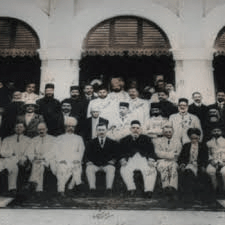In 1913 the heavy toll of life taken by indiscriminate firing on a Muslim mob protesting against the demolition of a portion of the Kanpur Mosque stirred and prompted the first signs of widespread serious criticism of British rule amongst Muslims of the Subcontinent.
The misadventure occurred after the Government of U.P. approved quarter of a million rupees for the welfare work in Kanpur. The scheme included widening of A. B. Road that became a burning issue among Hindus because of a temple that was located on the way. Since the Hindus forced the Government not to abolish the temple, the Public Works Department amended the master plan and decided to change the direction of the road. According to the alternative plan, there was an eastern portion of a mosque located opposite to the temple that had to be destroyed. When the Muslims came to know, they were exceedingly embarrassed. They demanded that no portion of the mosque should be demolished in order to widen the road.
The British tried to convince the Muslims that the portion of the mosque that was to be demolished was not the part of the mosque as that that was only used for ablution. The Muslims who were not prepared to accept their plea presented a memorial to Lt. Governor U.P. in which they categorically called for protection of the mosque in toto. Thereupon on May 6, 1913 Lt. Governor Sir James Meston who was quite indifferent to the religious sentiments of the Muslims after visiting the site of the mosque adamantly rejected their demand and issued orders for its demolition. The orders were accordingly executed by the Public Works Department in the presence of the police the very next day. The demolished portion of the mosque intensely provoked the Muslim community of the city. On the other hand, Lt. Governor Sir James Meston ordered the magistrate of Kanpur to handle the situation with iron hands.
On August 3, 1913 the Muslims of Kanpur gathered at Eidgah and held a meeting in which Muslim leaders delivered emotional speeches. As soon as the meeting was over, an angry mob carrying black flags gathered before the Mosque and began to place loose bricks in place of the dismantled structure so as to show their resolution for reconstruction of the Mosque. Mr. Tylor, the magistrate of Kanpur ordered the police to open fire on the armless protestors. The firing continued for 15 minutes and about six hundred rounds of cartage were discharged. Several Muslims were killed and injured and so many of them were captured and put behind the bars. After this catastrophe, Sir James Meston’s act of distributing merit certificates among the policemen who participated in the firing further hurt the Muslim community and added fuel to the fire.
The Muslim press throughout India criticized this brutal act of Kanpur administration. All India Muslim League seconded the opinion of the Muslim Press and passed two resolutions on August 31 and September 19. In the resolutions AIML demanded for the appointment of a committee comprising both officials and civilians to conduct an impartial inquiry. Furthermore, Maulana Muhammad Ali and Syed Wazir Hasan, Secretary AIML were delegated to present the Muslim case before the British Government at London. The delegation effectively briefed the British about the Kanpur tragedy and also advocated for “a suitable form of self-government for India. Raja Sahib of Mahmudabad also held a meeting with the Lt. Governor and informed him that the resentment of the Muslims was not regional but on national level. Maulana Muhammad Ali especially took active part in the agitation for the restoration of the mosque and advised Muslims of the subcontinent to express their sentiments strongly as otherwise every police sub-inspector was likely to become a Tylor for them.
On October 13, 1913 Lord Hardinge himself visited the site of the demolished portion of the mosque in Kanpur on the request of Syed Ali Imam. He worked out a compromise with the Muslims and allowed them to construct a new arcade over the public road. He also ordered for the release of the Muslim prisoners and withdraw cases against them. Many of the Englishmen openly opposed this act of Hardinge. The Anglo Indian press criticized him and considered that it would lead to more troubles by various Indian factions.
In short, after 1911, the annulment of the partition of Bengal, the crisis in the Balkans and the Kanpur mosque incident of 1913 created the conditions for major phases of the discourse and politics of the Indian Muslims.
This article was last updated on Monday, Jan 01, 2007






